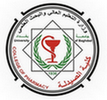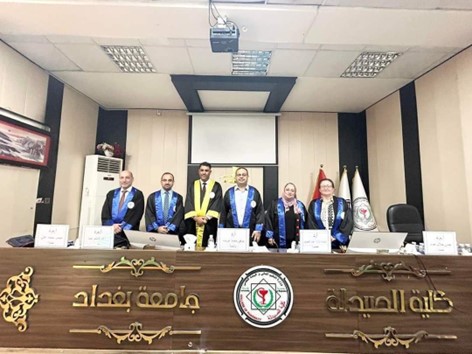The College of Pharmacy discussed the PhD dissertation entitled “Pulmonary Paclitaxel-Loaded Sericin Nanoparticles: Preparation, Characterization, In vitro and In vivo Evaluation” by the student Mustafa Egla Kadhim and the supervisor, Professor. Dr. Nawal Ayash Rajab, at the Pharmaceutics Department. The study aimed to formulate sericin-based nanoparticles (NPs) containing paclitaxel (PTX) to provide targeted delivery to the lungs through inhalation by nebulizer. The study included the application of the design of the experiment method, Box-Behnken Design, for creating NPs. The self-assembly and accompanying dialysis procedures were used to prepare PTX-loaded sericin NPs. The design of the experiment aimed to examine the influence of four factors on responses [particle size, polydispersity index (PDI), and entrapment efficiency (EE)]. The factors included the concentrations of each of sericin and poloxamer 407, stirring speed, and stirring time. The NPs were evaluated for particle size, PDI, and EE%, then optimized utilizing the desirability function through computer-based experimental design using the ®Design Expert software. Subsequently, the optimum formulations were investigated for an in vitro drug release study. From the in vitro release data and other optimum properties, the selected formulation was defined. The selected NPs formulation, composed of (0.6% PTX, 4.5% poloxamer 407, and 1.8% sericin), was subjected to several characterization processes including assessments of zeta potential, transmission electron microscopy (TEM), in vitro cytotoxicity study using A-549 lung cancer cells, and in vitro aerosol lung deposition test. Then, the formulation and the Taxol® product were administered separately to rats by nebulization for quantification of PTX deposited in the lungs, as well as histopathological studies and bioimaging studies. The results showed that the concentrations of poloxamer 407 and sericin constituted the two most influential variables on particle size. For PDI, the most influential parameter was sericin concentration, while the stirring speed and poloxamer 407 concentration were the most effective parameters on EE%. The optimization process suggested three formulations (S1, S2, and S3) with the highest desirability function (more than 94%). The in vitro release of PTX from optimized formulations was slow and controlled within 24 h for the three optimized formulations. The S3 formulation showed better results in terms of particle size (less than 200 nm, both liquid and lyophilized after reconstitution), a PDI of (0.241), an EE of (82%), and the in vitro release data (85% in 24 h); therefore, it was selected as the best formula. The zeta potential was (-28.02 mV). Transmission electron microscopy confirmed that the NPs were spherical in shape, with a core-shell structure. The NPs showed an enhanced anticancer activity against A-549 cells, with cell viability of (18%) compared to the free PTX (62%) after 72 hours. Assessment of the aerodynamic properties of the NPs revealed the efficiency of the present nanocarrier systems for drug delivery deep into the lung for the treatment of non-small-cell lung cancer (NSCLC (disease. The percent of PTX dose deposited in the lungs of rats after 1h was (45.24%) from the S3 formulation and (6.96%) from the Taxol® product, indicating the highest PTX deposition from the S3 formulation. No significant histopathological changes were observed in the lungs of rats after administration of the S3 formulation, indicating the biosafety of this formulation. The in vivo bioimaging study showed the fluorescence intensity was predominantly concentrated in the lungs of rats, suggesting a selective buildup of NPs at the intended location rather than in other tissues. The study concluded that the pulmonary administration of this formulation may present a new and promising approach for better targetability and delivery of PTX for the treatment of lung cancer.




